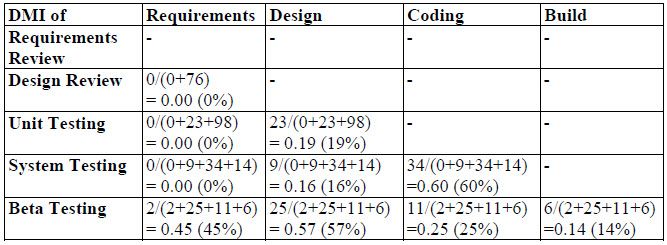Testing science states that it is impossible to achieve 100 percent test coverage in testing software. Based on the risks in a project, the desired amount of test coverage is arrived at and established. It is impossible to uncover all the defects early in the software development life cycle. For example, performance defects remain uncovered until the software is integrated and moved to the performance testing lab. This article puts forth a metric that depicts the status of defect migration.
Objective of Testing
Integration Testing uncovers some defects that ideally should have been uncovered in Unit Testing itself. System Testing uncovers some defects that ideally should have been uncovered in Integration Testing. Extrapolated, Customers unearth defects that ideally should have been uncovered by the Software Development Organization. Testing aims at finding defects in the product before the customer identifies it and make it defect-free. A Migrated Defect is defined as a defect that ideally should have been found in any of the previous testing phases. Stopping the Defect Migration is one of the key objectives of any Testing Activity
The product is excellent. There is always a scope for improvement. The product undergoes changes and accommodates enhancements. This makes Regression Testing inevitable. Foreseeing the future becomes inevitable to stop defect injection and it is one of the key objectives of any Testing Activity.
Why Defect Migration happens
Testers are human. The errors that human psychology permits apply here as well. This natural phenomenon needs to be overseen. Scientific principles indeed teach the relevant testing methodologies to minimize the risk of this human psychology inhibiting the defect migration but not to mitigate it.
It is practically impossible to achieve 100% test coverage. This leaves the tester with the fact that some customer in some corner of this world is going to execute a test path that is not covered in (his/her) testing.
Software Developers write code that works adequately, considering the additional work needed there as an ‘enhancement’. They defer doing the same attributing it to other work pressure. They often provide justification to the top management in unusual ways and this eventually results in the migration of the defects.
Reviews are the best way to uncover defects early in SDLC, though it is costly. Project Manager failing to justify the review that needs to be scheduled allows the defects to get migrated.
Defect Migration Accounting
Measuring a Quality Attribute and taking necessary steps to enhance their quality ensures Continuous Improvement in the quality of the Attribute. Defect Migration Index (DMI) measures Defect Migration from one phase to another.

DMI accounts for the migrated defects to a testing phase. In an ideal environment, it should be zero.
Consider the following Defect Distribution–An Example
The below is the DMI Chart for the above distribution.



Significance of DMI
DMI serves as a metric that shows the status of effectiveness of the testing in stopping the Defect Migration. Unlike Defect Removal Efficiency, this accounts for defects migrated from any Phase X to Phase Y.
DMI chart shall occupy a section in the Project Closure Analysis Report. The Top Management shall use DMI as the measure of the performance of the testing activity. In the above example, DMI of System Testing to Coding = 0.60. This indicates that Unit Testing is not convincing and needs improvement.
Acknowledgements
I take this opportunity to thank Sudha Pichumani, Tanushree Parial and Neeraja Thyagarajan for reviewing this article. The time and effort they have taken to review this article and making it more comprehensive is highly appreciated.


